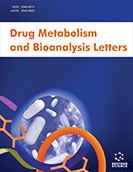Abstract
Objective: The mechanism-based inhibition of macrolide antibiotics, such as erythromycin and clarithromycin, and piperine on testosterone 6β-hydroxylation activities by cytochrome P450 (CYP) 3A4, polymorphically expressed CYP3A5, and fetal CYP3A7 were compared.
Methods: 6β-Hydroxy testosterone was determined by high-performance liquid chromatography.
Results: Although preincubation with erythromycin and clarithromycin decreased CYP3A4- mediated testosterone 6β- hydroxylation in a time-dependent manner, and the estimated maximum inactivation rate constant (k inact) and the inactivation rate constant reaching half of k inact (K i) for erythromycin were approximately 1/2 and 1/5, respectively, of those for clarithromycin. Obvious preincubation time-dependent inhibition of erythromycin against CYP3A5 and CYP3A7 was not observed. Piperine exhibited preincubation time-dependent inhibition and the calculated K i and k inact values for CYP3A4 were approximately 1/7 and 1/2, respectively, of those for CYP3A5.
Conclusion: It is speculated that the preincubation-dependent inhibition by piperine would be more potent in CYP3A5 non-expressors than CYP3A5-expressors.
Keywords: CYP3A4, CYP3A5, CYP3A7, macrolide antibiotics, piperine.
Graphical Abstract
[PMID: 8035341]
[http://dx.doi.org/10.1124/dmd.104.000794] [PMID: 15304429]
[http://dx.doi.org/10.1038/86882] [PMID: 11279519]
[http://dx.doi.org/10.2174/138920008783331121] [PMID: 18220568]
[http://dx.doi.org/10.1248/jhs.56.239]
[http://dx.doi.org/10.2165/00003088-200645010-00002] [PMID: 16430309]
[http://dx.doi.org/10.1016/0003-9861(85)90383-2] [PMID: 4026319]
[http://dx.doi.org/10.1016/j.abb.2019.108078] [PMID: 31445893]
[http://dx.doi.org/10.1093/oxfordjournals.jbchem.a122632] [PMID: 2722762]
[http://dx.doi.org/10.2165/00003088-200544030-00005] [PMID: 15762770]
[http://dx.doi.org/10.1124/dmd.119.088955] [PMID: 31748224]
[http://dx.doi.org/10.1081/DMR-120001392] [PMID: 11996015]
[http://dx.doi.org/10.3109/03602532.2015.1011658] [PMID: 25678418]
[http://dx.doi.org/10.18433/jpps30558] [PMID: 31339834]
[http://dx.doi.org/10.1016/j.abb.2020.108283] [PMID: 32001245]
[http://dx.doi.org/10.1248/bpb.28.188] [PMID: 15635191]
[http://dx.doi.org/10.1248/bpb1978.4.879] [PMID: 7328489]
[http://dx.doi.org/10.1124/dmd.31.7.945] [PMID: 12814973]
[http://dx.doi.org/10.1046/j.1365-2125.2000.00261.x] [PMID: 11012550]
[http://dx.doi.org/10.1124/dmd.32.10.1083] [PMID: 15377640]





























